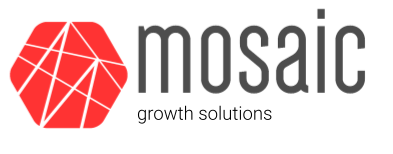Content has long been and continues to be one of the most important components of an effective go-to-market motion. For organizations that don’t have a well-defined content strategy, addressing content development can be extremely overwhelming. We have good news – it doesn’t have to be. In this Mosaic Minute, we will discuss the importance of content, break down different types of content, and share a few tips on how to get started on building your library.
What role should content play in your go-to-market strategy?
In short, content should help you establish authority, build trust with your prospects, drive engagement throughout the buyer’s journey, and enhance the customer experience. Executed successfully, a consistent content strategy not only delivers value to your stakeholders but it also creates tangible value for your organization in the form of more leads, increased sales conversion, and greater customer retention.
What are the different types of content?
To keep it simple, we focus our clients on 3 different types of content.
- High Value – There is high-value thought leadership content that is meant to showcase a brand’s depth of expertise and knowledge. In addition to building authority in the market, it should also deliver clear value to prospects and customers. Whether it is content about how to overcome existing pain points and challenges or about emerging industry trends, it should offer value that is not contingent on buying your product. Examples of this would be white papers, guides, product data, research, blog posts etc. The majority of this content is relevant to prospects and customers.
- SEO – While all content can be optimized for search, there are cases where it is necessary to create content specifically for SEO. As we like to say, this isn’t “Pulitzer prize-winning” content but it gets the job done while still being useful to prospects.
- Sales Enablement – Content plays a critical role across the entire buyer’s journey, but some content should be especially designed to address active buyers – those that are considering purchase and/or are trying to make a decision. Think buyer’s guide, customer testimonials, and case studies.
How do you create content strategically and efficiently?
Building a content library from scratch can seem daunting, especially if your competitors are well ahead of you. Here are a few tips to help you get started quickly.
- Find untapped assets – Reach out to key stakeholders across the organization to see if they have existing content that just needs a little clean up and formatting. Think customer case studies, testimonials, insights from product data, research materials, etc.
- Identify multi-purpose content – The reality is that a piece of content can fall into more than one of the categories outlined above. To get started, we advise clients to develop content that can serve multiple purposes – perhaps a white paper that can serve as a lead-generation offer on LinkedIn, value-added insight within a top-of-the-funnel lead nurture workflow, or an asset that the sales team can use to engage with active buyers.
- Leverage Internal resources – Identify content topics that can be addressed through a combination of existing organization insight/knowledge, internal SMEs, and availble resources. For example, something that requires you to conduct external research is not the best place to start your content efforts.
- Check on the competition – Use your competition to drive content efforts in 2 ways. First, identify top keywords (by volume) where you are being outranked by competitors and create content with the sole purpose of one-upping them. You can also check out the high-value content your competitors are putting out and create similar materials with your own brand voice and insight.
- Don’t forget happy customers – Work with the sales team and customer success team to identify satisfied customers who might be willing to chat with you. Even just 30 minutes with an enthusiastic customer can generate enough content to create a mini case study (pain points, why they chose your solution, how the solution has helped them) that can be used in a variety of ways by both marketing and sales.
TL;DR
Content remains one of the most important parts of any go-to-market strategy, but we also find that many clients do not invest in content and their results suffer as a result. Because it is so important there is also a lot to consider when thinking about developing a content strategy, use the simple guidelines above to get started, but do get started. Starting now, even if not perfect, will help your brand and will provide learning opportunities to improve your efforts.


Recent Comments